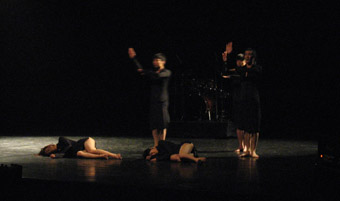 |
Darkness Poomba photo Phalla San |
A spot picks out a man standing with a microphone in one of the aisles. Ears and eyes are immediately drawn to this powerful presence and we are captivated as the space swells with his chanting of the traditional Korean Poomba (a wordless street song associated with both begging and festivities), evocative of desperation and yearning. Manipulated reverberation suggests that we are all inside a cold and mysterious vault of some sort, suspended between hallucination and reality. The performer displays extraordinary command of his instrument, and his sensitive commitment to the dancers on stage helps them to devote themselves to the dark abrasiveness of the space.
Later in the work, a dance with metallic dinner trays between the two male dancers who opened the piece brings an oddly domestic sensibility to the abstract world that has been established. The trays become percussive instruments as well as hats and items of clothing. The chorus of dancers behind them acts as a strata of strange shadows that morph from one contained image to the next. The dance is realised with crisp articulation and un-wavering performance energy as if the dancers are teasing out the dark underbelly of this work with a quiet ferociousness.
The darkness of this rich work is both deeply set in the bones of the performance and ironically woven into its surface. Even when the whole audience claps and sings in delight when the work turns into a rock concert, the haunting atmosphere never lets up. In fact it is in these 'light' moments that the gothic undertone is somehow heightened, demonstrating a sophisticated approach to the creation of atmosphere. Funereal organs and regular smoke machine emissions are both parodic and unsettling.
When choreographer and dancer Kim Jae Duk joins the vocalist in the auditorium and two electric guitarists play at either end of the stage, the traditional lilt of the Poomba becomes the wailing power of a rock concert, the guitars providing the metallic grit for the transition. The audience too has been transformed, from theatre spectators into a rock stadium crowd.
In a return to the opening duet, the two dancers perform a gradually accelerating version of the robotic Siamese twin dance down the aisle towards the stage. This phrase cleverly functions as the peak of the work, causing a kind of ‘Mexican wave’ effect on the crowd, evident in a vocal eruption. After the excitement has subsided, a gentle, virtuosic harmonica solo is performed by Kim Jae Duk, cleverly returning us to the work's opening eeriness. As the creator lays his final delicate mark, the piece closes.
Not one sense is privileged over another in this haunting re-contextualization of the traditional South Korean melody of Poomba. In a truly interdisciplinary and multi-layered work, audience members are taken on a strange and unexpected voyage through the realms of contemporary dance, traditional song, stadium rock and festive reggae. Perhaps seeming schizophrenic and disjunctive in nature, this collage of performance genres is in fact executed seamlessly. Darkness Poomba is a work that manages to constantly transform our environment before we have even noticed, each new world functioning as a critique of the one that has come before.
10th Indonesian Dance Festival: Kim Jae Duk Project, Darkness Poomba, choreographer, composer, dancer, musician Kim Jae Duk, with dancers and musicians; Graha Bhakti Sudaya, June 14
Cat Ruka is an emerging choreographer and performance artist from Auckland, New Zealand. She is currently developing her interest in dance criticism and is the editor of Yellingmouth, an Auckland-based dance review blog.
© Cat Ruka; for permission to reproduce apply to [email protected]








 back
back